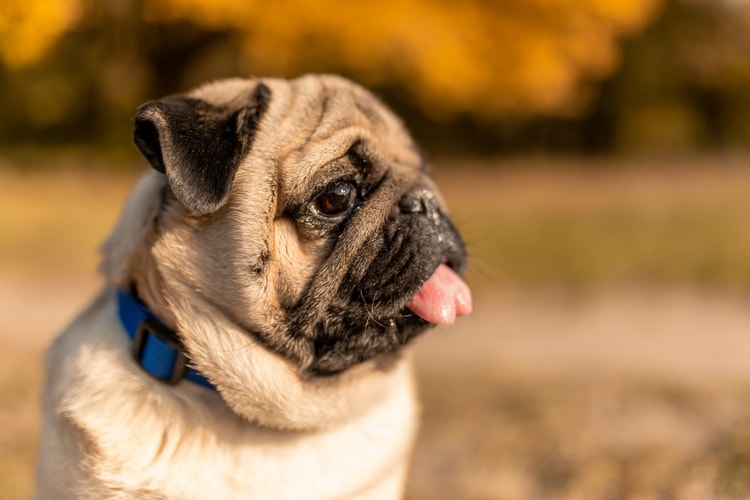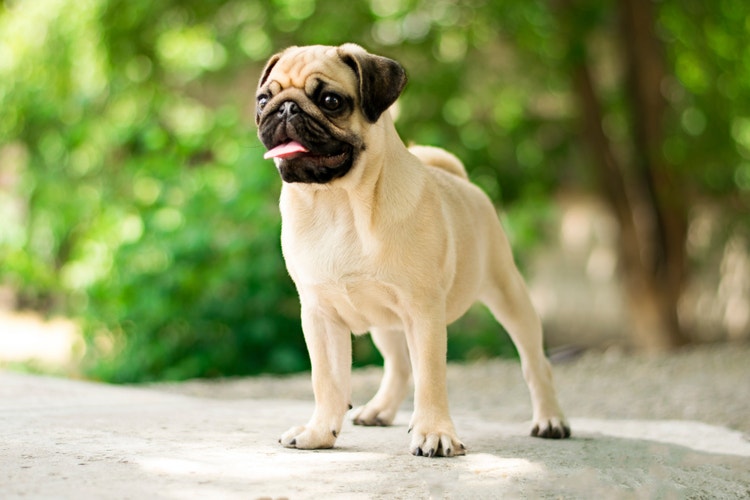
Pug


Where Are Pugs From?
The name “Pug” is suggested to have many different origins. In Latin, the word pugnus means fist, which the Pug’s head is thought to resemble. They are also referred to as carlin in France, carlini in Italy, Mops Hund in Germany, Lo-sze in China, and mophand in the Netherlands. The Pug is the largest of the toy breeds and is also a companion animal. They originated in China and have been traced back to the first century B.C. They were royal dogs in their native land and were often gifted to overseas rulers. The oldest breeding records from China include descriptions of Pug-like dogs with both straight and bowed front legs, which may indicate interbreeding with the Pekingese, Japanese Chin, and Shih Tzu. The breeding records also describe fawn, black, and parti-colored coats.
It is believed that Holland was the first European country to acquire a Pug via the Dutch East India Company. In 1688, when William III and Mary II traveled from Holland to Great Britain to begin their reign as King and Queen, they brought their beloved Pugs along with them. The Pugs wore orange ribbons to represent the House of Orange and henceforth, Pugs became a symbol of supporters of the royal family. Black Pugs were not formally introduced until 1877 and almost entirely unknown until 1886, when Britain’s Lady Brassey showed her black Pugs in Maidstone, Kent. The Pug was officially recognized by The American Kennel Club in 1885.
Caring for a Pug
Do Pugs Have Weight Problems?
Do Pugs Have Weight Problems?
The Pug thoroughly enjoys food and can easily become overweight. As a brachycephalic breed, they are prone to respiratory abnormalities and obesity can further exacerbate these breathing issues. Monitoring your Pug’s caloric intake and weight can help prevent obesity. Limiting table scraps may seem difficult, due to their adorably wrinkly faces, but it will help maintain a healthy weight.
If your Pug becomes overweight, an appropriate weight management plan should be discussed with your veterinarian.
Do Pugs Need to Be Groomed?
Do Pugs Need to Be Groomed?
The Pug’s short coat requires minimal grooming, only routine brushing, and periodic bathing. Frequent cleaning of the wrinkles of their face will help prevent moisture build up, which can lead to dermatitis.
Do Pugs Have Health Issues?
Do Pugs Have Health Issues?
Pugs are predisposed to a variety of health concerns. They are a brachycephalic breed, meaning they have a short nose and flat face. This makes them prone to heat intolerance, respiratory distress, elongated soft palate, stenotic nares, everted laryngeal saccules, and a narrow trachea. Because of their prominent eyes and wrinkled forehead, the Pug is prone to several ocular diseases, such as proptosis, corneal ulcers, and entropion. Therefore, routine eye examinations are recommended. Proptosis can be caused by trauma to the head and/or neck, so using a harness instead of a neck lead is suggested for a Pug. This will help minimize the risk of a trip to the ER for an ocular emergency. They can also suffer from hip dysplasia and should have routine orthopedic exams as well. Hip dysplasia can be exacerbated by obesity, which is yet another reason to keep a Pug’s weight in check. The Pug also suffers from skin diseases and neurologic diseases. Their life span is 12 – 14 years.
Pugs are predisposed to: hip dysplasia, patellar luxation, elongated soft palate, Stenotic nares, everted laryngeal saccules, entropion, demodectic mange, atopy, melanoma, mast cell tumors, heat stroke, pug encephalitis, dystocia, distichiasis, keratoconjunctivitis, and proptosis.
How to Train a Pug
How to Train a Pug
The Pug is an intelligent and amiable breed, making them fairly easy to train using standard obedience methods. Given their love of food and family, teaching with small training treats (as long as they are veterinarian approved) will surely keep them motivated. Their patient and non-aggressive temperament, along with their square and sturdy body frame, make them wonderful companions for children.
How Much Exercise Does a Pug Need?
How Much Exercise Does a Pug Need?
The Pug does require some mild exercise since they are prone to obesity, but this should be done with caution. As a brachycephalic breed, they are predisposed to heat intolerance and respiratory distress. Too much exercise or taking them outside in high temperatures can result in heat stroke. Brief, short distance walks in mild temperatures are best for this breed.
Engaging in play with your Pug in a cool environment is a safe way to maintain a healthy weight in warmer climes. However, it is imperative to closely monitor their breathing and provide access to water during any exercise or training session with a Pug.
What Are the Physical Traits of a Pug?
Pug Facts
Other Breeds to Explore
References
- Morris, Desmond. Dogs: The Ultimate Dictionary of Over 1,000 Dog Breeds. Trafalgar Square, 2002.
- American Kennel Club. The Complete Dog Book. Random House Digital, Inc., 2006.
- Wilcox, Bonnie and Chris Walkowicz. The Atlas of Dog Breeds of the World. T.F.H. Publications, Inc., 1995.


